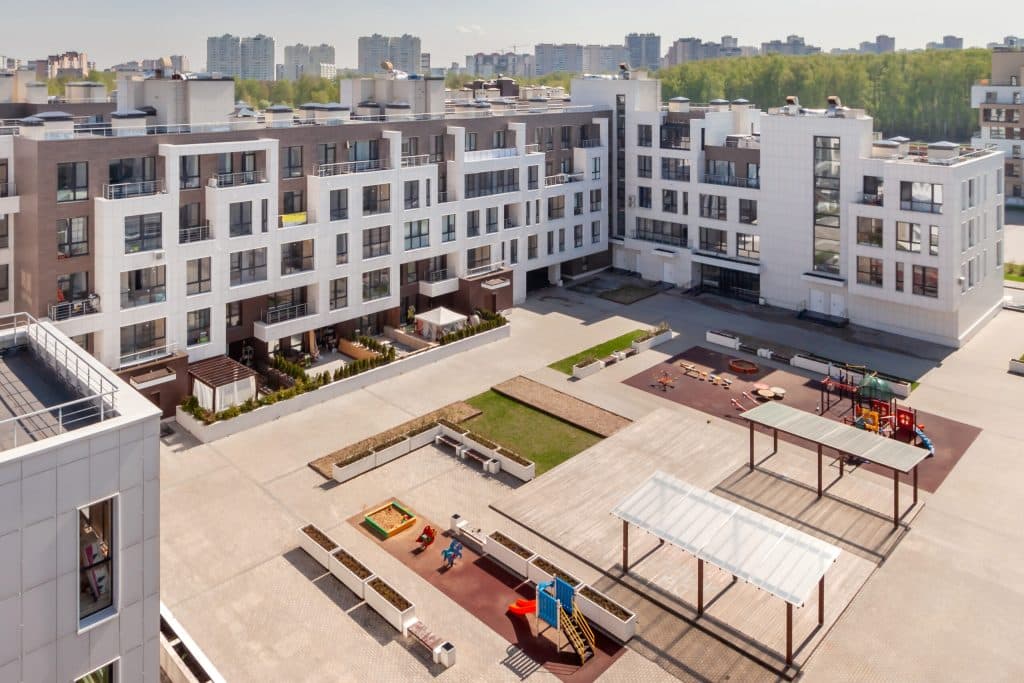
Why Midwest Mixed-Use Urban Environments are Trending Upward
March 15, 2022
While urban planning and regeneration across the Midwest continues to fuel investment in cities and their surrounding neighborhoods, the pandemic has shifted work patterns and brought the demand for hybridized environments into sharp focus.
As city dwellers increasingly seek public spaces that maximize convenience and connection, mixed-use developments can unlock potential by offering variety and vibrancy under one roof.
The Rise of Live, Work, Play Urban Spaces
Mixed-use developments–environments that blend retail, restaurants, offices and residential spaces–are not new to the real estate and construction landscape: they have been a popular choice for over a decade. Properties that blend commercial and residential space offer a live, work, play model to locals, who can enjoy proximity to recreational outlets for eating, drinking, shopping and entertainment.
In many ways, the live, work, play model of urban development takes what is attractive about a city lifestyle and maximizes it. Urban settings are exciting places to live because residents can walk from place to place, enjoying proximity to work and amenities like shops and restaurants.
In mixed-use developments, office workers can leave work and find themselves a few feet from bars and fitness centers. Residents can shop, eat or grab a drink just minutes from home.
Consumers benefit from walkable environments, eliminating long commutes. Less driving means more walking, promoting a healthy lifestyle, minimizing pollution and creating more time for connection with family, colleagues and friends.
With everything they need close at hand, communities can enjoy increased convenience, green space, connectivity and vibrancy in an environment that naturally attracts new residents and customers.
Hybridized Business Spaces
As COVID-19 reshaped work/life patterns, it also brought about a surge in online sales, prompting a re-evaluation of the benefits of brick-and-mortar retail spaces in urban living. In-person shopping allows retailers to connect with customers and offer personalized experiences to particular communities. To tap into this, retailers are taking the mixed-use model further.
Hybridized retail models allow business owners to create and curate consumer experiences, combining multiple, desirable opportunities under one roof. Customers can enjoy a coffee while shopping for clothing, sample wines while visiting an art exhibit, or browse for records in a local brewery.
By adding second or third components to commercial spaces, business owners can enjoy the benefits of multiple revenue streams while keeping overheads low. Consumers who would have had to travel to several different locations can now take advantage of multiple experiences in an immersive urban environment that can evolve from day to night.
Curated Events for Community and Residential Spaces
Curated events are on the rise, too. Gyms offer guest DJs and special classes, and restaurants and bars hold themed events targeting specific markets.
Residential spaces also reflect these shifts. The lockdowns of the pandemic have emphasized the value of socially enriching experiences. That means a rewrite of how residents use community spaces like gyms and wellness centers.
Property managers are now partnering with companies specializing in the development projects curating tenant-focused events, like fitness classes, to activate shared spaces, increasing the value offered to tenants.
Evolved Flexibility of Midwest Mixed-Use Development and Residential Units
While both urban and suburban communities benefit from mixed-use models, the fast pace of an urban lifestyle calls for spaces designed for evolution. Hybrid models of retail and recreation offer diversified income streams to business owners. Consumers, meanwhile, benefit from convenient and vibrant experiences and increased opportunities for community engagement and connection.
The pandemic stimulated a new understanding of urban environments: what they offer, what they lack, and in the future, how they can evolve. By promoting flexible models of living, working and doing business, mixed-use developments can meet the shifting needs of city dwellers today and prepare urban spaces for the next phase of revitalization.
Midwest Urban Residents Benefit from Mixed-Use Development
The Midwest is experiencing a notable upward trend in the popularity of mixed-use urban environments, driven by a confluence of factors including urban planning, changing work patterns, and the desire for convenience and connectivity.
The rise of live, work, play urban spaces has transformed the way people experience cities, offering proximity to work, leisure, dining, and entertainment all within walking distance. This model not only enhances convenience but also
-
Promotes healthier lifestyles
-
Reduces pollution
-
Fosters community connections
Additionally, hybridized business spaces and curated events are redefining retail and recreational experiences, while the flexibility of mixed-use developments allows them to adapt to evolving urban needs.
As the pandemic reshapes our understanding of urban living, these mixed-use environments are well-positioned to cater to the changing demands of city dwellers, providing vibrant, connected, and adaptable spaces for the future of urban revitalization in the Midwest.
___
Engaging a full-service CRE partner like Farbman Group can help spark positive change within your investments. Contact us and get in touch with an expert today.
Related Posts

Crain's Notable Commercial Real Estate Leaders
Blog Post | July 17, 2024
Click Here for Full Article Scope of work: Andrew Gutman worked his way up at myriad commercial real estate firms to lead Farbman Group, Farbman companies, 30 million rentable square feet...
Read More
What’s a Broker to Do? Tight Vacancy and High Interest Rates Mean No More Slam-Dunk Deals
Blog Post | July 9, 2024
Brokers Have to Get Creative — as in Create Deals Brokers need to study their local markets like never before and know who the top buyers and sellers are, stressed...
Read More
Connect Midwest Multifamily Panelists on 2024 CRE Trends
Blog Post | June 26, 2024
CRE experts from the recent Connect Midwest Multifamily conference in Chicago reflected on their experience and the importance of meeting customer needs in business. As the age-old mantra says,...
Read More